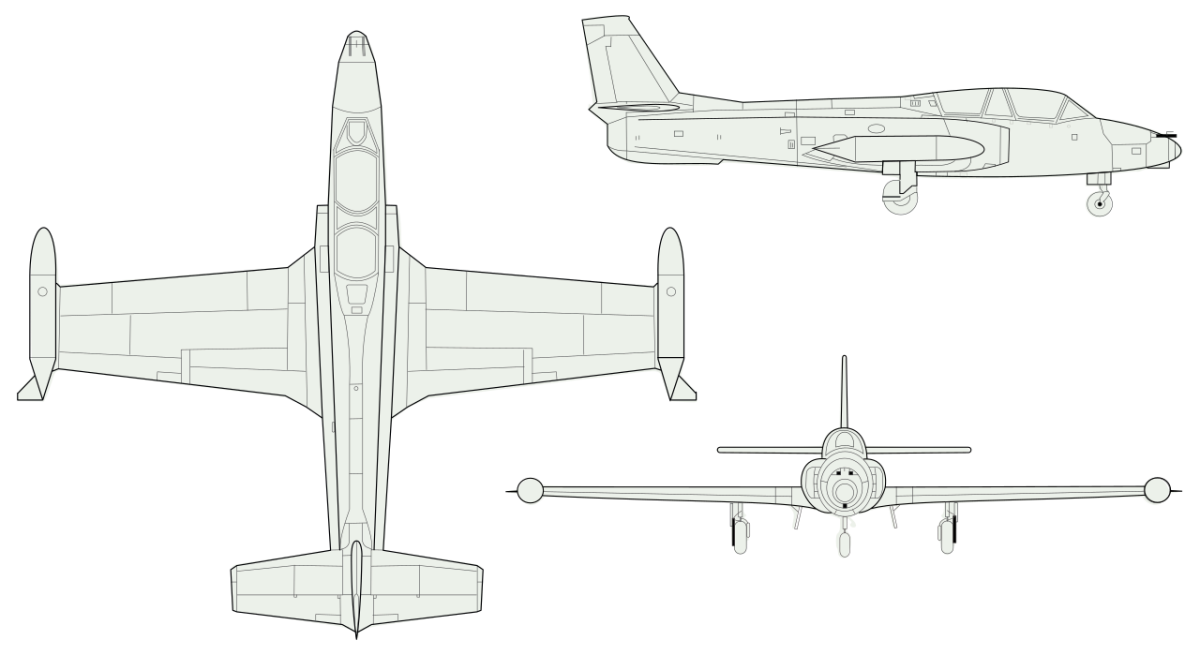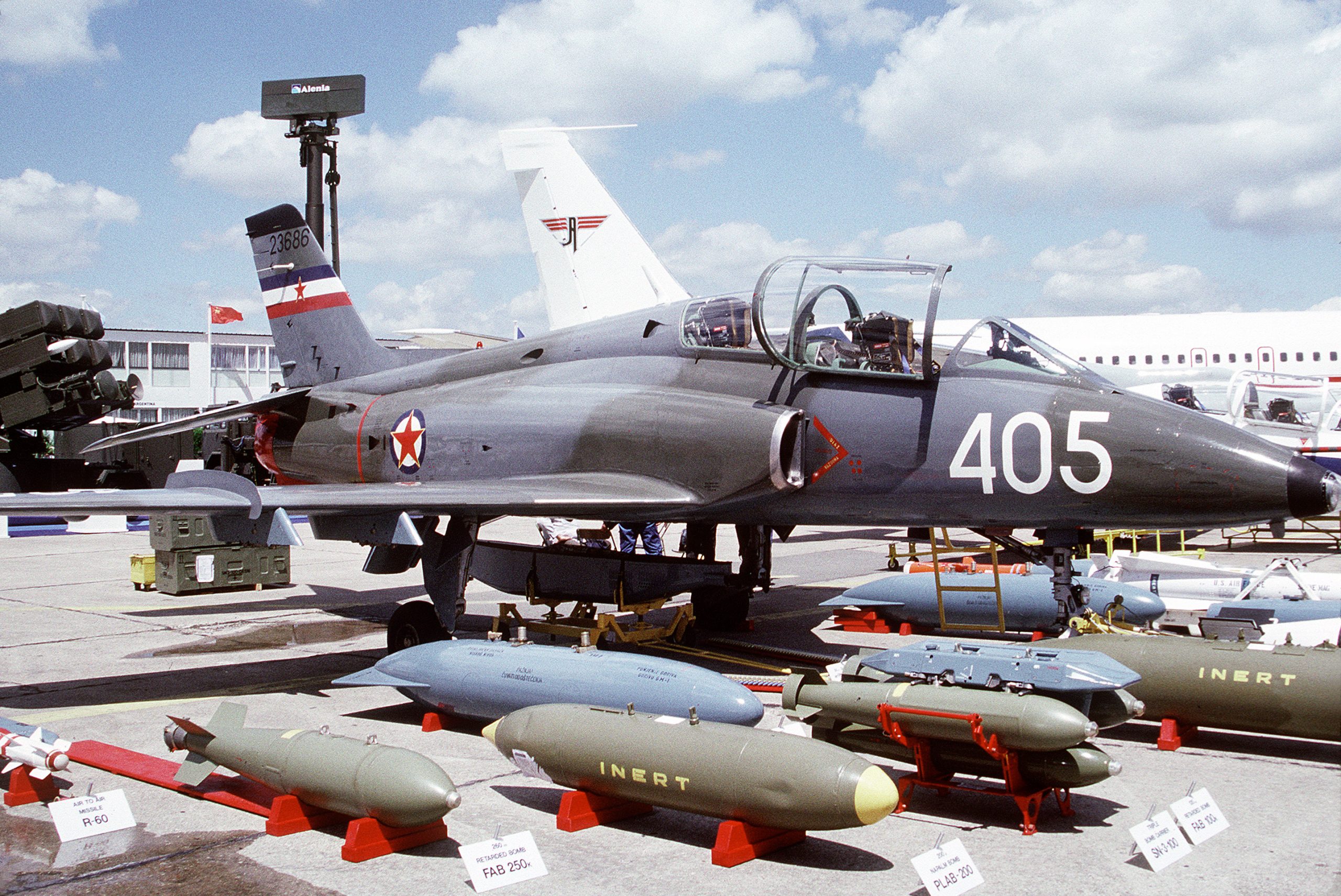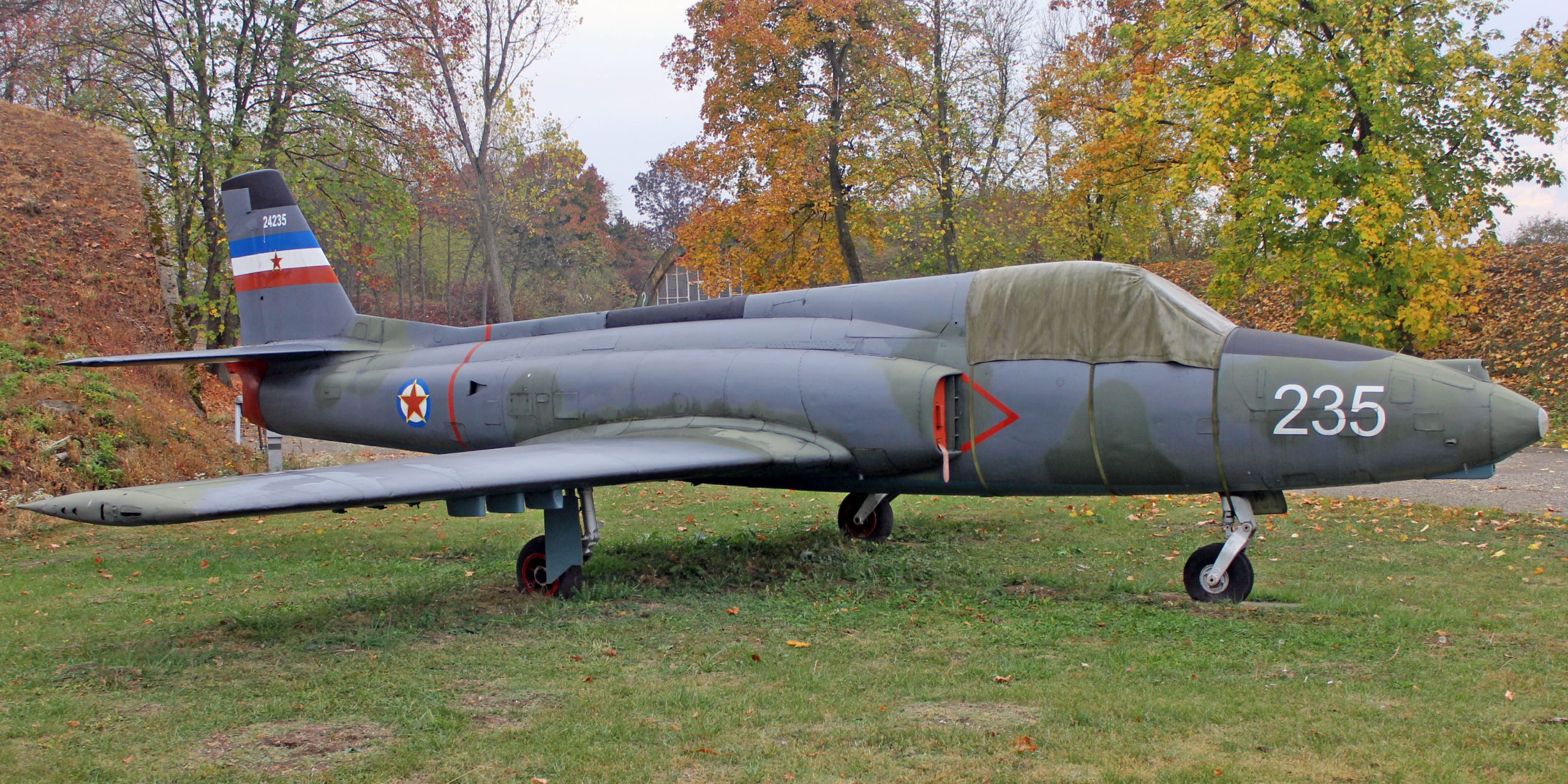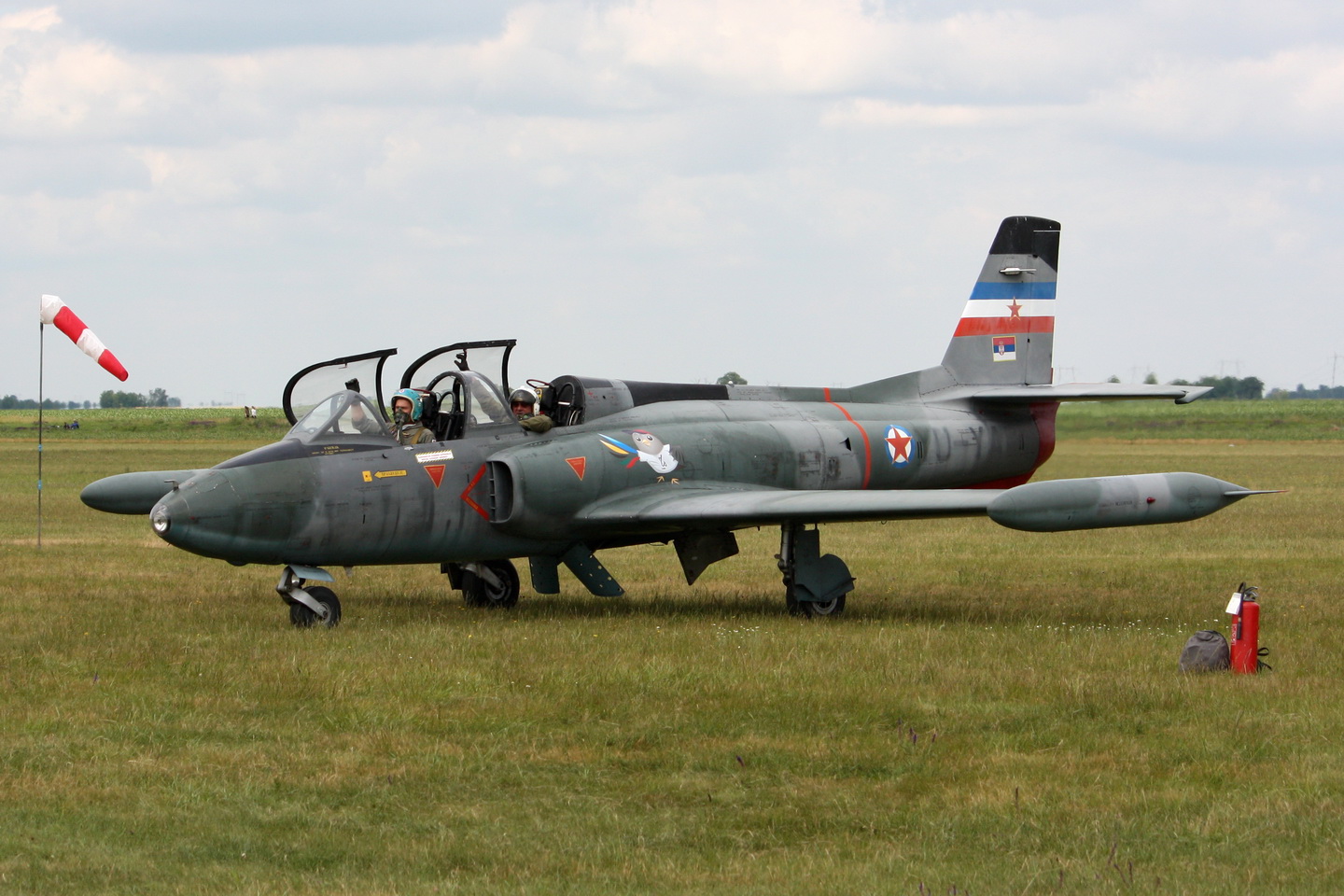The Soko G-4 Super Galeb, or N-62, is an advanced jet trainer and light ground-attack aircraft designed by the Aeronautical Technical Institute at Žarkovo and manufactured by the SOKO aircraft factory in Mostar. This Yugoslav single-engine aircraft, commonly called the Super Galeb (Eng. Super Seagull), was developed during the 1970s to succeed and replace the Soko G-2 Galeb, which was then in service with the Yugoslav Air Force.
Introduction
On July 17, 1978, the G-4 PPP, a development aircraft, conducted its maiden flight. 1983 the first G-4 Super Galeb production model took to the skies. Quantity production began in 1984, with the assembly line operating until the dissolution of Yugoslavia in 1991. A total of 85 aircraft were built, primarily for the Yugoslav Air Force, while six G-4s were exported to Myanmar.
During the Yugoslav Wars, Yugoslavian Air Force G-4s were employed for ground-attack missions, losing four aircraft to enemy air defenses. In 1992, the remaining planes were relocated to Serbia and Montenegro, where they entered service with the Air Force of the newly-formed FR Yugoslavia. The Republika Srpska Air Force retained one G-4 Super Galeb aircraft. The Serbian Air Force has become the largest operator of this type, obtaining additional Super Galebs from other former Yugoslavian republics. The Serbian Air Force plans to upgrade and continue operating its G-4 Super Galebs until the 2030s.

Development
Developed in the 1970s, the G-4 Super Galeb was created as a replacement for the existing fleet of the G-2 Galeb, a straight-winged jet trainer aircraft utilized by the Yugoslav Air Force. The Galeb had been developed in the late 1950s and was the predominant trainer aircraft in the Yugoslav Air Force before 1999. The Super Galeb exhibited a clear lineage from its predecessor, sharing the same Rolls-Royce Viper turbojet engine sourced from Britain, albeit enhanced for improved performance. However, it is worth noting that the Super Galeb was an entirely advanced aircraft, bearing little resemblance to the G-2 Galeb aside from their shared role, as highlighted by aviation historian Christopher Chant.

During the initial phase, two prototypes of the Super Galeb were reportedly completed by early 1978. After successful ground testing, the aircraft’s maiden flight occurred on July 17, 1978. This was followed by the first flight of one of the six pre-production aircraft on December 17, 1980. The pre-production models, including the prototype, were designated G-4 PPP. They featured fixed tailplanes with inset elevators and lacked anhedral. In contrast to the G-2 Galeb, the Super Galeb had swept wing and tail surfaces. It also integrated avionics that enabled flight in adverse weather conditions and at night.
The production G-4 and the second prototype were designated as G-4 Super Galeb and differed from the development aircraft in various design aspects. They featured an all-moving anhedral tailplane and were equipped with comprehensive avionics improvements. While the earlier development aircraft used a pressurized refueling system, the production models employed a gravity-based refueling system, which was simpler and more cost-effective, albeit slightly slower.

In addition to its training role, the G-4 was also suitable for light attack operations. By 1983, the G-4 Super Galeb had completed its first flight and received significant orders from the Yugoslav Air Force. It competed internationally against other jet trainers, such as the Italian Aermacchi MB-339, the Czechoslovakian Aero L-39 Albatros, and the Spanish CASA C-101. Although the G-4 offered lower performance than the Franco-German Dassault/Dornier Alpha Jet, it was considerably more affordable to procure, as stated by Flight International.
Design
The SOKO G-4 Super Galeb is a jet trainer and a light attack aircraft. Its dimensions make it suitable for various flight syllabuses, including basic and advanced training. The G-4 Super Galeb visually resembles the Hawker Siddeley Hawk, a contemporary British jet trainer. The aircraft features a low-wing monoplane design with slightly tapered wings. It has a length of 12.25 meters (40.2 ft), a height of 4.3 meters (14 ft), and a wingspan of 9.88 meters (32.4 ft). The aircraft’s empty weight is 3,250 kilograms (7,170 lb), and it can carry up to 1,882 kilograms (4,149 lb) of fuel.
The G-4 Super Galeb is equipped with a short nose cone, a rounded fuselage, a conventional empennage, semi-circular air intakes, a vertical tailfin, a rudder, ailerons, horizontal stabilizers, and fuel tanks located at the square tips. The tandem seating configuration accommodates two crew members: typically, a student and an instructor. Each position is equipped with ejection seats sourced from Martin-Baker. The rear seat is slightly raised to provide better all-around visibility and facilitate the supervision of a student pilot in the front seat. The crew is equipped with avionics that enable flying in poor weather conditions. The forward position includes a radio altimeter and a gyro-gunsight.
For combat missions, the G-4 Super Galeb can be fitted with a centerline-mounted gun pod housing a twin-barrel 23mm Gryazev-Shipunov GSh-23L cannon, capable of carrying up to 200 rounds. Additionally, four hardpoints are located under the wings. The inboard pair has a capacity of 770 pounds (350 kg), while the outboard pair can hold 550 pounds (250 kg). These hard points can accommodate a range of armaments and equipment from both Western and Eastern European sources. The inboard pylons are equipped to carry 70-gallon external fuel tanks, and a locally developed reconnaissance pod was also in development at one point.
Powering the G-4 Super Galeb is a single Rolls-Royce Viper turbojet engine sourced from Britain. Over time, the aircraft’s performance has been significantly enhanced by adopting the more powerful Rolls-Royce Viper 632-46 engine. For additional performance, attachment points for jet-assisted take-off (JATO) rockets are present underneath the fuselage. To reduce landing distances, a drogue parachute can be deployed. The engine can be accessed directly by removing the rear fuselage forward of the fin.
Operational history
In the early 1990s, Yugoslavia initiated an upgrade program for its G-4 Super Galeb fleet. The primary focus of this program was the integration of new air-to-air and air-to-ground missiles, improved aiming capabilities, enhancements to increase engine reliability, and upgraded electronics. These modifications aimed to enhance the aircraft’s combat capabilities and overall performance.
During the Yugoslav Wars, the G-4 Super Galeb was actively involved in numerous combat missions. It is reported that three G-4s were shot down during these operations, but fortunately, all pilots could eject safely. The Yugoslav Wars led to the breakup of Yugoslavia into multiple smaller nations, with each nation inheriting a portion of the former Yugoslavian aircraft inventory.

During the NATO bombing of Yugoslavia, seven G-4 Super Galebs belonging to the ZVEZDA aerobatics team were destroyed at Golubovci Air Base. This significant loss heavily impacted the team, leading to its disbandment in 1999. However, a group of Serbian aviation enthusiasts later formed a new display team. This new team utilizes older Soko G-2 Galebs, previously withdrawn from service in the 1980s.
Since 2008, the Serbian Air Force, being the largest operator of the G-4 Super Galeb, has proposed a comprehensive upgrade program for their remaining G-4Ms. The planned upgrade, known as G4-MD, primarily focuses on integrating new avionics for improved navigation, enhanced control systems, and the integration of new combat systems. These upgrades are expected to extend the aircraft’s service life until the 2030s.
To expand its operational fleet, Serbia has acquired additional G-4 Super Galebs from other former Yugoslavian republics through various means, often involving bartering and negotiation.
Variants
The G-4 series consists of different aircraft models, including:
G-4 Galeb
85 advanced jet trainers and light ground-attack aircraft were produced and deployed.
G-4Š
Five aircraft were manufactured as unarmed jet trainers.
G-4T
Three aircraft were dedicated target tug models.
G-4M
This variant is based on six G-4 Super Galeb and features upgraded avionics, additional hardpoints, and missile rails added to the wingtips. The avionics package includes a Zrak ENP-MG4 Heads-Up Display (HUD) with a Rudi Cajavec ENS-MG4 electronic sight, gyro platform, multi-function displays, and optional chaff/flare dispensers. The inner hardpoints have a capacity of 500 kg, while the outer hardpoints can carry up to 350 kg, resulting in a maximum disposable load of 1,800 kg. The normal takeoff weight is 4,971 kg in the trainer configuration, while the attacker configuration allows a maximum takeoff weight of 6,400 kg.
In the “clean” configuration, the aircraft achieves a maximum speed of 865 km/h at 10,000 m and 900 km/h at 4,000 m. It has a ferry range of 2,900 km with drop tanks, a range of 1,800 km with standard fuel, reduced to 1,200 km when carrying a cannon pack, four BL755 cluster bombs, and two air-to-air missiles. Other performance features include a maximum rate of climb at sea level of 1,800 m per minute and a service ceiling of 12,500 m.
G-4MD
This model represents a modernized version of the 15 G-4 Super Galebs currently in service with the Serbian Air Force, while the remaining nine aircraft remain unmodified. The G-4MD upgrade includes various enhancements such as LCD flight screens, Hands-On Throttle and Stick (HOTAS) controls, HUD, integrated mission computers, distance measuring equipment, GPS-based navigation systems, identification friend or foe capabilities, nav comm units, mission records, and VHF Omni range and instrument landing systems. Integrating guided weapons, countermeasures, and targeting systems is also scheduled for this comprehensive upgrade program.
Technical specifications
| Country of origin: | Yugoslavia |
| Manufacturer: | SOKO Mostar, Yugoslavia |
| Type: | basic trainer/light attack aircraft |
| Crew: | 2 |
| Introduced in service: | 1983 (first flight July 17, 1978) |
| Powerplant: | 1 × Rolls-Royce Viper 632-46 turbojet, 17.8 kN (4,000 lbf) thrust |
| Fuel capacity: | 1,882 kg (maximum internal and external fuel) |
| Dimensions: | 9.88 m / 32 ft 5 in length including probe 12.25 m / 40 ft 2.25 in height 4.30 m / 14 ft 1.25 in |
| Weight (empty): | 3,172 kg / 6,993 Ib |
| Weight (combat): | 4,760 kg (10,494 lb) |
| Max. flight mass: | 6300 kg / 13,889 Ib |
| Maximum speed: | 491 kt / 665 mph / 1,070 km/h |
| Range: | 1,900 km / 1,180 miles |
| Armament: | provision for one 23-mm GSh-23L two-barrel cannon with 200 rounds; provision for 2053 kg (4,526 Ib) of disposable stores, including AAMs, bombs, cluster bombs, dispenser weapons, napalm tanks, large-caliber rockets, rocket-launcher pods, drop tanks and ECM pods, carried on four external hardpoints |
| Equipment: | provision for one 23-mm GSh-23L two-barrel cannon with 200 rounds; provision for 2053 kg (4,526 Ib) of disposable stores, including AAMs, bombs, cluster bombs, dispenser weapons, napalm tanks, large-caliber rockets, rocket-launcher pods, drop tanks, and ECM pods, carried on four external hardpoints |
| Operators: | Bosnia and Herzegovina, Myanmar, Montenegro, Serbia |



